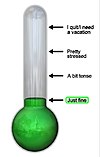User:Nashville whiz
Appearance
Hello, it's me.
I'm an active editor "apparently trying" to improve history-related pages. My area of interest mostly lies in the Arab conquest of Persia and Spanish Golden Age. Currently, I'm involved in fixing grammatical errors such as subject-verb agreement errors, improper punctuation, incorrect spelling, inappropriate word choices and etc. I believe that every page must be well organized and paragraphs must adhere to strict unity in their ideas.
Feel free to leave me a message in my talk page. Thank you!

Useful links
[edit]Earth is the third planet from the Sun and the only astronomical object known to harbor life. It is the densest planet in the Solar System and the largest and most massive of its four rocky planets. About 29 percent of Earth's surface is land, with the remaining 71 percent covered with water and much of Earth's polar regions covered in ice. Earth's interior is active with a solid-iron inner core, a liquid outer core that generates Earth's magnetic field, and a convective mantle that drives plate tectonics. Earth formed more than 4.5 billion years ago. Within the first billion years of Earth's history, life appeared in the oceans and began to affect Earth's atmosphere and surface. Since then, the combination of Earth's distance from the Sun, its physical properties and its geological history have allowed life to evolve and thrive, including more than 8 billion humans as of 2024. Earth is orbited by one permanent natural satellite, the Moon, which orbits Earth at a radius of 384,400 km (238,900 mi) and is roughly a quarter as wide as Earth. This photograph of Earth straddling the lunar horizon was taken in 2015 by NASA's Lunar Reconnaissance Orbiter while located 134 km (83 mi) above the crater Compton, visible in the foreground. To capture the image, the spacecraft had to be rolled 67 degrees to its side, and slewed with the direction of travel to maximize the width of the lunar horizon, while traveling more than 1600 m/s (3600 mph) relative to the surface.Photograph credit: NASA / Goddard Space Flight Center / Arizona State University; edited by Bammesk

